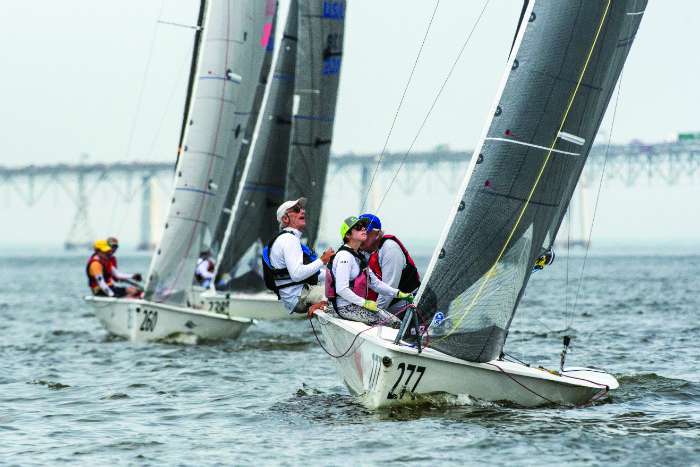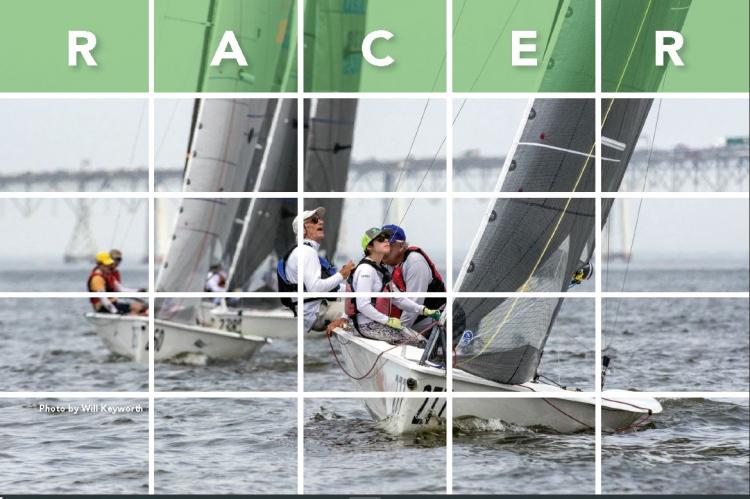Making a Small Boat Racing Game Plan… and Throwing It Away!
I’m somewhat of a creature of habit. To get my brain rolling every morning, while I’m eating breakfast, I play Wordle. I always use the same first word (I have my reasons why, but I’m not giving away any secrets!), and if I don’t get any letter “hits” on that first word, I have a standby second word. That’s because Wordle is always played under the same conditions: Six chances to get the right five-letter word. And it’s only me who’s playing that individual game.
Sailboat racing isn’t always the same, as conditions are not only different day to day and venue to venue, but they also change during an individual race (or leg). And there are those pesky competitors sharing the racecourse, making your decision making even more complex. Still, it is important to develop a game plan for several reasons. Sailing around hoping you’ll magically just go faster and encounter good luck on the wind shifts isn’t a winning strategy.
The process of developing a game plan helps you identify key elements on the course (and near the course) that can help you move ahead in your fleet. Where is there better breeze? Where is there more advantageous current? Figuring out where good things and bad things can happen can help you develop an initial game plan, along the lines of “go right early for better breeze, but be sure to get back toward the center of the course before you hit the adverse current at the top right corner.”
Be sure to develop your game plan not only based on weather and current forecasts, but also on your actual observations.
Developing a game plan helps you decide where you want to go on the course and helps you in your interactions with other boats. When you have a game plan, it’s a lot easier to make decisions. If you’re sailing upwind on port and are about to encounter a starboard-tack boat and need to decide (tack before them or duck them) and you know from your game plan that the top right corner is not a good place to be, tacking before them is a clearer choice.
Racing on a boat with more than one person, collaboratively developing that game plan and making sure the key elements are spoken out loud (avoid bad current; watch for the lefty at the top, etc.), helps your entire team be on the same page. Is the wind better or has it shifted right on the righthand side? Plan for a gybe set (but verify before rounding!). That way, when quick decisions are needed, you’re all acting as one.
So, everything is great in game-plan-world, right? You and your team are racing along with clearly defined, commonly shared goals, but…
It’s okay to develop a game plan—remember, you benefit from just the process of coming up with the game plan, because you are more informed about the racecourse—but it’s also okay to toss it out the window if you need to.

When might you need to abandon your game plan?
If conditions change. While certainly you have examined the weather forecast and know what might evolve over the course of your racing day, your game plan is for a shorter time period: just one race. If the forecasted storms roll in a little early, pulling the breeze hard one way or the other, you may need to ditch that game plan to take advantage of the emergent conditions.
If you’re sailing super short courses. With super short courses (half an hour or less) you need to be able to jump on every advantage that presents itself. While your decisions will be informed by your game plan, you will be more affected by short-term tactics than overall strategy.
If you’re up for a high-risk move. Super bad start and you’re flailing around in the back of the fleet? Is everyone in front of you following your game plan to head out to the right to catch that nice puff? Might be time for a high-risk leg, especially if you have a drop race you can use. If you try something risky—less breeze, but less traffic and fewer wind shadows on the left—and it doesn’t work out, well, there’s your drop race.
If you need to keep tabs on your close competitors. In the last race or two of a major regatta, you may be focused on staying ahead of (or playing offense against) one or a small handful of competitors. Be sure to run the match, and carefully consider how any drop races may affect things. If you know you need to simply stay ahead of a boat to stay ahead of them in the overall standings, but that how other boats finish won’t affect your place, and that one boat decides to tack away from the side you have emphasized in your game plan? Welp, you’ve got to stay ahead of them, so looks like you may need to divert from your game plan!
Whether you are—or aren’t—following your game plan, having a plan, sharing it with your teammates, and continuing communication on the status of the game plan will help you to succeed.
About the Author: SpinSheet Small Boat columnist for more than a dozen years, Kim Couranz has earned several national and world titles in Laser Radials (ILCA 6) and Snipes. She has also raced J/22s, J/24s, and Ynglings on an international level.





